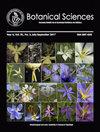墨西哥三个地区辣椒的表型分化及其与气候的关系
IF 0.7
4区 生物学
Q3 PLANT SCIENCES
引用次数: 1
摘要
背景:墨西哥领土的大部分地区都有黄辣椒的种群,它是许多与墨西哥饮食相关的栽培形式的祖先。问题:表型和遗传变异在其采样区域、种群和种群内的分布比例是多少。气候如何与种群的表型变异相关。种:辣椒变种。研究地点和年份:对来自三个地区的24个种群进行了抽样:西北部、索诺拉州和锡那罗亚州;南部:瓦哈卡州、墨西哥的塔巴斯科东南部和尤卡坦州。该实验在2016年至2018年期间进行。方法:从野生种群中采集单株果实。植物生长在温室里。进行嵌套方差分析来估计不同空间尺度的表型和遗传方差分量。通过单变量和多变量方法估计了气候相关性。结果:49.8%的表型变异发生在家系内,11.1%的表型变异出现在家系间(群体内),21.3%的表型变化出现在群体间,17.6%的表型差异出现在区域间。表型变异的遗传基础平均为50.1%,区域间遗传变异34.2%,群体间遗传变异39.4%,群体内遗传变异26.3%。气候因素对营养、叶面和生殖性状产生了不同的相关性模式。结论:西北植株矮小,叶小果大,东南植株高大,叶大果小,南方植株具有中等表型特征。气候解释了表型分化的很大一部分。本文章由计算机程序翻译,如有差异,请以英文原文为准。
Phenotype differentiation of Capsicum annuum var. glabriusculum of three regions in Mexico and its relation to climate
Background: Populations of Capsicum annuum var. glabriusculum are found in a wide portion of the Mexican territory, and it is ancestor of many cultivated forms relevant for the Mexican diet.
Questions: What are the proportions of phenotypic and genetic variation distributed among its sampled regions, populations and within populations. How does the climate correlates to the population’s phenotypic variation.
Species: Capsicum annuum var. glabriusculum.
Study sites and years: 24 populations form three regions were sampled: Northwest, states of Sonora and Sinaloa; South: Oaxaca and Southeast Tabasco and Yucatán, in Mexico. The experiment was performed between years 2016 to 2018.
Methods: Fruits from single plants were collected in wild populations. Plants were grown in a greenhouse. Nested ANOVAS were performed to estimate phenotypic and genetic variance components for different spatial scales. Climate correlation was estimated through univariate and multivariate methods.
Results: 49.8 % of phenotypic variation was detected within families, 11.1 % among families (within populations), 21.3 % among populations and 17.6 % among regions. The genetic basis of phenotypic variation was 50.1% on average, for this genetic variation 34.2 % was found among regions, 39.4% among populations and 26.3 % within populations. Climate factors generated different patterns of correlations for vegetative, foliar and reproductive traits.
Conclusions: Northwest plants were shorth, with small leaves and large fruits, Southeast plants were tall, with large leaves and small fruits, South plants developed intermediate phenotypic traits. Climate explained a large proportion of phenotypic differentiation.
求助全文
通过发布文献求助,成功后即可免费获取论文全文。
去求助
来源期刊

Botanical Sciences
Agricultural and Biological Sciences-Plant Science
CiteScore
1.90
自引率
21.40%
发文量
71
审稿时长
16 weeks
期刊介绍:
Botanical Sciences welcomes contributions that present original, previously unpublished results in Botany, including disciplines such as ecology and evolution, structure and function, systematics and taxonomy, in addition to other areas related to the study of plants. Research reviews are also accepted if they summarize recent advances in a subject, discipline, area, or developmental trend of botany; these should include an analytical, critical, and interpretative approach to a specific topic. Acceptance for reviews will be evaluated first by the Review Editor. Opinion Notes and Book Reviews are also published as long as a relevant contribution in the study of Botany is explained and supported.
 求助内容:
求助内容: 应助结果提醒方式:
应助结果提醒方式:


